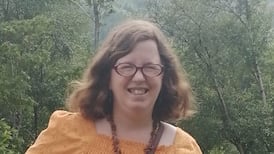Journalist
Ian Bailey
has said he has no recall of writing the words: “Back in print again, hip hip hooray” after doing interviews with a journalist related to events surrounding the murder in west
Cork
of French film-maker
Sophie Toscan
du Plantier in late 1996.
Luán Ó Braonáin SC, for the State, said the note containing those words was dated June 30th, 1997, shortly after Mr Bailey met Sunday Independent journalist Brighid McLaughlin in Schull while she was researching a story arising from the December 1996 murder.
The writing in the note did not look like his and he had no recall of writing those words but he may have done so, Mr Bailey said.
Counsel also put to Mr Bailey it was incorrect to give the impression his second arrest, on January 27th, 1998, was solely on the basis of claims he had intimidated Marie Farrell, a local shopkeeper who had made statements to gardaí.
Mr Bailey denies any intimidation of Ms Farrell and the jury has been told she will give evidence she was put under pressure by gardaí to make statements concerning Mr Bailey which she later retracted.
His cross-examination continues today in his action for damages against the Garda Commissioner and State on grounds including alleged wrongful arrest and conspiracy arising from the Garda investigation into the murder of Ms Toscan du Plantier, whose body was found near Toormore, Schull, on the morning of December 23rd, 1996. The defendants deny the claims.
Yesterday, Mr Bailey agreed a main plank of his case is that his second arrest was mainly to do with the claims concerning Ms Farrell but said there were other planks. He had been chosen as a suspect and then gardaí tried to find evidence to put him in the frame, he said.
Tape recorder
He said he had met Ms Farrell in her shop by arrangement on June 28th, 1997 after she had approached him days earlier. He brought a tape recorder and showed that to her but did not use it as he would not do so without a person’s consent. Nor had she recorded their conversation.
He may also have brought a poem he had written about two gardaí but it was a “porkie pie” to say he brought a piece of paper with Ms Farrell’s address in London. He denied he was intoxicated.
Counsel put to Mr Bailey there were seven reasons for Mr Bailey’s second arrest, including various statements by journalists, photographers and some local people, including statements alleging Mr Bailey told some persons he had killed Ms Toscan du Plantier.
Mr Bailey said he did not accept there was any legal basis for either his first arrest on February 10th, 1997, or his second arrest on January 27th, 1998. During his second arrest a persistent theme was Ms Farrell and whether he was near Kealfadda bridge in the early hours of December 23rd, 1996, he said.
He denied it may have appeared to gardaí he had information concerning the murder that nobody else had, and said he had no such information.
He could not understand why a number of people had made certain statements except they may have been “suggestible”.
Counsel read Garda memos of five interviews between Mr Bailey and gardaí during his second arrest and Mr Bailey agreed the notes indicated the interviews ranged over several issues, including his knowledge of Ms Toscan du Plantier, statements by various journalists, photographers and local people and his movements on the night of December 22nd/23rd, 1996.
The interviews also included repeated insistence by Mr Bailey he had nothing to do with the murder.
During the proceedings, Mr Justice John Hedigan stressed the issue for the jury to decide is not whether Mr Bailey killed Ms Toscan du Plantier or whether the various statements made by him and other parties are true or not. The State's defence includes a plea there were reasonable grounds for gardaí to question and arrest Mr Bailey and that was why these matters were being put to him, the judge said.
Earlier, Mr Bailey agreed a note written by him on February 11th, 1997, the day after his release, was not put before the jury in his direct evidence. That note stated while he had told gardaí he had been in bed with his partner, Jules, on the night of December 22nd/23rd, 1996, he had, on reflection, recalled he had got up for a time because he had been anxious about a story he had to file. The note also recorded he had wondered was it best to go to Goleen that morning with his copy.
Photographs of murder scene
He denied he told a media photographer prior to 1.40pm on December 23rd, 1996, the time he claims he first learned of the murder, that he had photos of the scene where the body was found. A statement from another journalist concerning a conversation he had with Mr Bailey suggested Mr Bailey had visited the murder scene before the area being preserved by gardaí was extended, which occurred at noon that day, Mr Ó Braonáin said.
Mr Bailey denied he had told the picture editor of the Irish Independent, Padraic Byrne, that he had a picture of the murder victim he had taken himself and that she was a "very good-looking woman". Mr Bailey said he had never offered such a photo but had offered to try and get a photo.
He also denied he had told a copytaker he had keys to Ms Toscan du Plantier’s house.
Earlier, he agreed he told broadcaster Pat Kenny on February 14th, 1997, it was reasonable for gardaí to consider him a suspect for the murder. In hindsight, and at that particular time, it was reasonable, he said. Mr Kenny had also noted it was "highy unusual and irregular" for a suspect's name to be published in the media, he added.









